Dark Spot Laser Treatment
Dark spots can form on the skin due to environmental factors, such as sun damage, or skin conditions, such as melasma. Dark spots that occur due to excessive sun exposure and sun damage, also known as age spots, sun spots, solar lentigines, or liver spots, are characterized by small brown or gray discoloration areas. These areas of hyperpigmentation form most frequently on the face, neck, arms, and hands – the areas of the body that are most frequently exposed to the sun. Tanning and forgetting to wear sun protection, such as sunscreen or protective clothing, and getting a sunburn may seem like no big deal during your youth. Still, as we age, sun damage can lead to increased production of pigment in the skin, contributing to the formation of dark spots. Unlike freckles that fade over time, sun spots will not go away on their own, leading many patients to wonder what treatment options are available to reduce the appearance of pigmented lesions. Luckily, expert board-certified dermatologist Dr. Michele Green has a number of treatments for dark spots and hyperpigmentation available at her New York City dermatology office.
Dr. Green is an expert in a wide range of treatment options for eliminating dark spots on the body, including laser treatments, chemical peels, microdermabrasion, topical skincare products, and Intense Pulsed Light (IPL). Some of the most effective treatments for reducing hyperpigmentation include laser treatments, such as the Fraxel laser, Clear + Brilliant Laser, Candela Alex-Trivantage laser, Picosecond lasers, and Intense Pulsed Light. With options that are safe for patients of all skin tones and skin types, laser treatment for dark spots targets hyperpigmentation in the skin without damaging the surrounding tissue. Many laser treatments are non-ablative, meaning that they do not require an incision to be made, and very minimal downtime is required following the treatment. To find out which laser treatment option will be the most effective at addressing dark spots on your skin, schedule an initial consultation with Dr. Green, who will examine the treatment area and determine the treatment plan that will be safest and most effective for you.
Experienced board-certified dermatologist Dr. Michele Green has been expertly treating patients at her Upper East Side New York City dermatology office for more than 25 years. In addition to treating cases of age spots and hyperpigmentation, Dr. Green is a master at addressing other effects of the natural aging process, such as fine lines, wrinkles, sagging skin, volume loss, and uneven skin tone and skin texture with such treatments as Botox, dermal fillers, laser treatments, microneedling, chemical peels, and more. Along with addressing cosmetic concerns, Dr. Green provides many treatment options for medical conditions associated with dark spots, including skin cancer, melasma, and rosacea. With her proprietary line of skincare products, MGSKINLABs, Dr. Green can recommend the highest quality topical lightening creams, lotions, cleansers, acne treatments, and sunscreens. Well-known for high patient satisfaction through feedback and testimonials, Dr. Green has been consistently voted one of the best healthcare providers in New York City by such publications as Castle Connolly, Super Doctors, and New York Magazine.
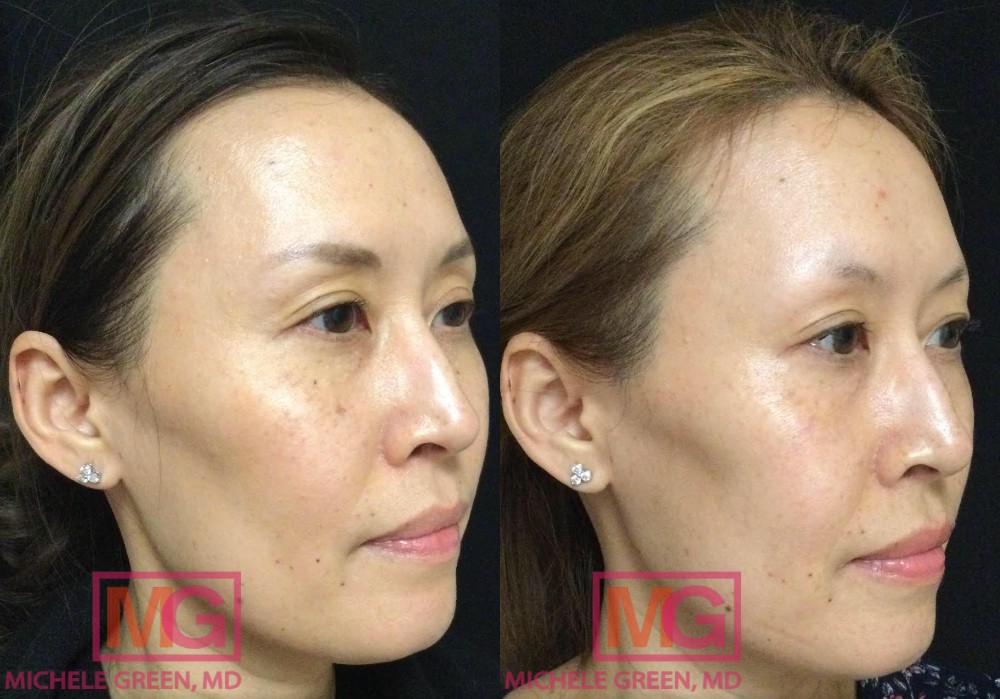
What are age spots (brown spots)?
Age spots are areas of hyperpigmentation characterized by small brown or gray spots on the skin’s surface. Most often, these brown spots, also known as liver spots, solar lentigines, or sun spots, form due to unprotected exposure to harmful UV rays and are most commonly found on the face, hands, arms, and neck. Sunspots develop over time, usually appearing during middle age (40s-50s) due to the sun damage that occurs in youth. When the UV rays from the sun or tanning beds are absorbed by unprotected skin, they trigger the production of the pigment known as melanin, which helps to protect the area from harmful rays. However, these pigmented cells also result in dark spots or areas of hyperpigmentation, creating a spotty or uneven appearance to the skin. Age spots are not harmful to the body or a sign of skin cancer, but many patients are dissatisfied with their appearance on the body. Luckily, many treatment options are available to reduce unwanted pigmentation on the skin’s surface.
Can dark spots be removed by laser treatment?
Laser treatments for skin resurfacing and rejuvenation are an excellent option for removing dark spots on the skin’s surface. Several different types of lasers are available at Dr. Green’s New York City dermatology office for dark spot treatment, including Q-switched nd: YAG lasers, fractional lasers, Picosecond lasers, and Intense Pulsed Light treatment. Each type of laser treatment and IPL has a slightly different mechanism of action. Still, the general principle for many is that they admit a form of energy that targets pigmented cells – destroying them without damaging the surrounding tissue. These micro-injuries to the skin also boost the production of collagen, which leads to brighter, clearer, more evenly textured skin. Some lasers work via skin resurfacing, which stimulates skin cell turnover to exfoliate the pigmented skin, exposing more evenly toned skin. To find out which type of laser treatment is best for you, schedule your initial consultation with board-certified dermatologist Dr. Michele Green.
What type of laser removes dark spots?
Dr. Green has several different types of lasers that remove dark spots from the treated area using various methods of action. During your consultation appointment, Dr. Green will examine the treatment area and determine the type of laser that will be safest and most effective for you, keeping in mind your skin type and aesthetic goals. The most effective dark spot laser treatments, which are available at Dr. Green’s office, are as follows:
Candela Alex Trivantage Nd: Yag Laser is a Q-switched laser that emits a wavelength of light that is absorbed by the pigmented cells and turned into heat energy, which destroys the melanin-rich dark spots while leaving the surrounding skin unaffected. The micro-injuries caused by the laser emissions also trigger the body’s natural healing response and the increased production of collagen and elastin in the treatment area for decreased hyperpigmentation and more evenly textured skin. Dr. Green typically recommends that patients undergo 1-2 treatment sessions to provide the best results in the treated area. Patients do not require any downtime following the Candela Alex Trivantage laser treatment, and the treatment results will become visible 1-2 weeks after the session, with results continuing to improve for several months.
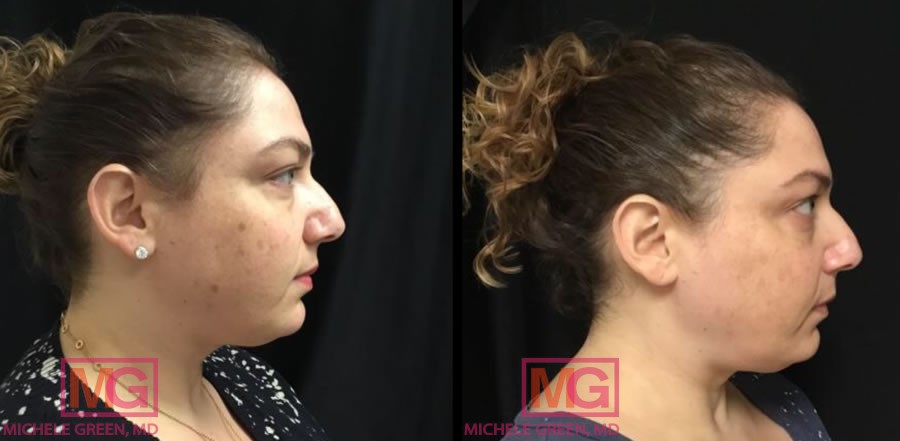
Fraxel Laser is a fractional laser that uses fractionated light energy to treat a fraction of the skin precisely, creating micro-wounds that lead to increased collagen production. This skin resurfacing treatment has two different wavelength settings: 1927nm wavelength to treat hyperpigmentation, such as dark spots, and 1550nm to improve skin texture and reduce the appearance of wrinkles and acne scars. By using the 1927nm setting to exfoliate the top layer of skin, the Fraxel laser eliminates dark spots on the skin’s surface with minimal downtime and long-lasting results. The Fraxel laser is safest to use on patients with lighter skin tones, as the treatment can cause laser burns and scarring on patients with darker skin. Patients with darker skin types can turn to the Clear + Brilliant laser, however, for similar results.
Clear + Brilliant Laser is a gentle fractional laser that is non-ablative and can be used on patients of all skin types and skin tones. Similarly to the Fraxel laser, the Clear + Brilliant laser can treat dark spots caused by sun damage, creating micro-injuries that boost new collagen production for improved skin tone and skin texture. Most patients will require a series of 5-6 treatment sessions for optimal results, and there is no downtime required following the procedure, meaning patients can immediately return to their regularly scheduled activities.
Pico Laser uses extremely short pulses of laser energy to target pigmented cells, destroying the melanin-rich dark spots. Unlike other laser treatment options that use heat energy, pico lasers rely mainly on speed, releasing millions of hyper-focuses bursts in less than a second. Similarly to other treatments, the Pico Lasers may require multiple treatment sessions to achieve the best results, but there is no downtime required following each treatment.
Intense Pulsed Light (IPL) is similar to laser treatment but differs primarily in its method of action. Where laser treatments can emit one wavelength of light at a time, IPL emits multiple wavelengths of light to address many skin conditions, including dark spots, acne scars, light wrinkles, large pores, and active acne breakouts. When the IPL device is applied to the treated area, the wavelengths of light are absorbed in the melanin-rich pigmented cells and converted into heat energy, which destroys the pigmentation there. There is very little discomfort associated with the treatment, and no downtime is required following the session. Intense Pulsed Light can also be used for hair removal.
Is laser dark spot removal safe?
Laser dark spot removal can be safe and effective for all, provided that the right laser treatment option is chosen for the patient. Some laser treatment options, such as the Candela Alex Trivantage laser and the Fraxel laser, are not safe for patients with darker skin tones. As these laser treatment options target the pigmented cells in the treatment area, they can cause damage to the surrounding skin with a high concentration of melanin. For patients with darker skin, Dr. Green recommends the Clear + Brilliant laser for dark spot removal, which is safe for patients of all skin tones. Patients with active acne breakouts, psoriasis, or cold sores should wait for the skin condition to clear up before undergoing laser dark spot removal to minimize the risk of infection and worsening conditions.
What are the side effects of laser brown spot removal?
It is important to choose the right laser treatment option to reduce the risk of any adverse events associated with laser spot removal, which is why it is essential to consult with an expert dermatologist, such as Dr. Green. Not all lasers are safe for patients with darker skin tones, and the wrong laser can cause laser burns, scarring, hyperpigmentation, or hypopigmentation in the treated area. When the right laser is chosen, the risk of serious adverse events is low. Some patients may experience mild, common side effects, which can include swelling, redness, irritation, slight bruising, crusting, and peeling. Following the laser dark spot removal session, patients should avoid sun exposure by staying indoors when the sun is at its most intense (between 10 am and 2 pm) and wearing sunscreen of SPF 30 or higher anytime they go outside during the day.
What is the pricing for laser spot treatment?
The cost of laser spot treatment depends on several factors, including your location on the map, the type of institution at which you receive treatment, and the size and scope of the treatment area. Institutions such as MedSpas will often offer laser spot treatment at a lower price. However, the risk of developing adverse side effects, such as laser burn, scarring, and hyperpigmentation, is higher at an institution like a medical spa. The cost of treatment from a board-certified expert dermatologist, such as Dr. Green, may be higher, but the risk of serious side effects is much lower. The total price of the treatment will also depend on the size and scope of the treatment area. Once Dr. Green has examined the treatment area and determined a treatment plan, her office can provide a closer estimate of the cost.
Can you laser off dark spots?
Laser treatment is an effective way to eliminate the appearance of dark spots on the skin caused by excessive sun damage. The first step is to schedule a consultation appointment with board-certified dermatologist Dr. Michele Green, who will examine the treatment area and discuss your aesthetic goals before determining the laser treatment that will be safe and effective for you. Dr. Green is well-versed in treating patients of all skin tones and types and knows which lasers will be safe for darker skin types and which will be safe for use. In the weeks leading up to the procedure, patients should avoid sun exposure and chemical exfoliants, which can irritate the skin. Laser treatment is generally quick and requires minimal discomfort during the procedure, though Dr. Green will often apply a topical numbing cream to increase patient comfort during the process. Depending on the size and scope of the treatment area, you may need multiple treatment sessions to obtain optimal results. Full, long-lasting results of the procedure should be visible within three to six months.
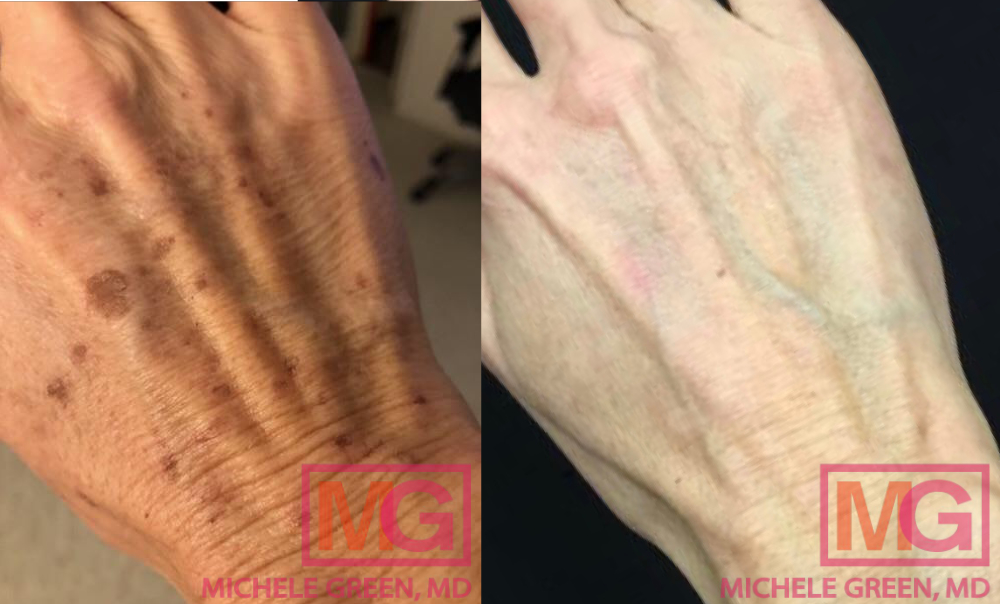
Which laser is best for dark spots?
Several types of lasers are available for treating dark spots at Dr. Green’s NYC dermatology office, including the Fraxel laser, Candela Alex Trivantage laser, Clear + Brilliant laser, and Picosecond lasers, and none are inherently better than the others. Instead, it is essential to choose the laser treatment that is safe and effective for your unique aesthetic goals and skin type. After your initial consultation with Dr. Green, she will make a recommendation for the type of laser treatment that will be best for you.
What is the best laser treatment for dark spots on the face?
Laser treatments and Intense Pulsed Light are very well able to address dark spots on the face and body via precise laser energy emissions that target pigmented cells in the skin. When looking to treat the face, Dr. Green will typically turn to the Fraxel laser, Candela Alex-Trivantage Nd: Yag laser, Clear + Brilliant laser, or Intense Pulsed Light. Any of these options will provide patients with excellent results, so it is all about finding the laser treatment plan that is safe and effective for you.
Which laser is best for dark skin?
Many of the laser treatment options target pigmentation in the skin, which can be highly effective at eliminating dark spots for patients with light skin. These treatments can be dangerous for patients with darker skin tones, as the laser energy can damage the surrounding skin, causing burns, scarring, hypopigmentation, and hyperpigmentation. For that reason, it is essential to choose a laser treatment option that is safe for skin of color. Dr. Green will usually turn to the Clear + Brilliant laser for patients with darker skin looking to remove age spots. The Clear + Brilliant laser provides similar results to the Fraxel laser without the danger of damaging skin color.
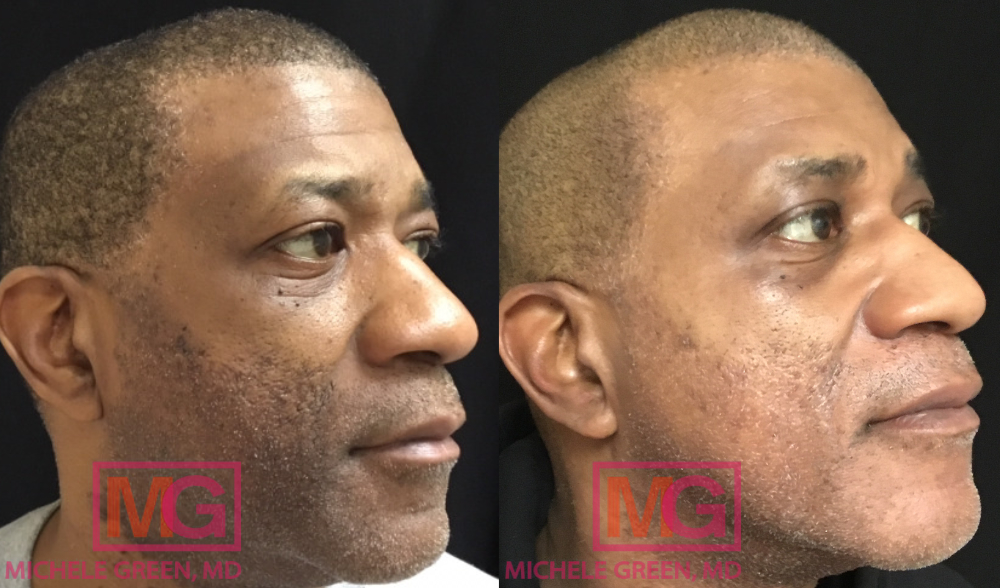
Which laser hair removal is best for dark skin?
In the past, laser hair removal was dangerous for patients with dark skin, as the available treatment options targeted the melanin in the hair follicle but would often be absorbed by the melanin in the surrounding skin tissue, leading to burns, scarring, and hyperpigmentation. Still, today, if the wrong laser is used on patients with darker skin types, there is a possibility of adverse events. There are certain types of lasers used in laser hair removal that can be safely used on patients with darker skin, specifically Nd: Yag lasers with a larger wavelength. Dr. Green will turn to the GentleYag laser for patients with darker skin tones to safely remove the hair at the treated area without the risk of laser burns, scarring, hyperpigmentation, or hypopigmentation.
Does laser hair removal help with hyperpigmentation?
Many patients ask, “Does laser hair removal get rid of hyperpigmentation?” While there are types of lasers that are designed to address hyperpigmentation associated with sun damage and aging and others that can be used to perform laser hair removal, the wavelengths that are used for addressing each skin concern are different. IPL is one treatment option that utilizes an array of different wavelengths to target various concerns and can be used to address pigmentation or hair removal, depending on the setting. However, Dr. Green usually recommends taking advantage of more targeted treatment options to ensure that you obtain optimal results while limiting potential side effects. At her private dermatology office in Manhattan’s Upper East Side neighborhood, she offers a host of innovative, non-invasive laser treatment options that can target an array of skin concerns safely and effectively.
There is, however, a type of hyperpigmentation that should never be treated with lasers: melasma. Melasma is a common, benign skin condition characterized by patchy skin discoloration that’s darker than the rest of the surrounding skin, usually affecting the cheeks, forehead, upper lip, and nose. Melasma should not be removed with laser treatments because the heat energy from the laser can further entrench the pigment into the deeper layers of the dermis. While laser treatment can sometimes temporarily improve the appearance of melasma, it often results in worsening its appearance and making it more difficult to remove later on. Instead, Dr. Green recommends treating melasma with chemical peels, Cosmelan, or Microneedling with depigmentation serum. If you are interested in laser hair removal and laser dark spot removal, share your aesthetic goals with Dr. Green during your consultation, and she can develop a treatment plan for both.
Does laser hair removal cause hyperpigmentation?
Laser hair removal is a safe and effective treatment for permanently removing hair in the treated area and is associated with very few side effects. Laser hair removal can cause hyperpigmentation, which is the darkening of skin patches; hypopigmentation, which is the lightening of skin patches; and scarring or burning for patients with darker skin tones if the wrong type of laser is used. That is why it is essential to seek treatment from an expert dermatologist, such as Dr. Green, who always ensures that the proper laser is used to keep each patient safe.
Does laser hair removal lighten dark spots? Does laser hair removal remove dark spots?
Patients sometimes ask, “Will laser hair removal get rid of dark spots?” The answer is that laser hair removal is designed specifically to target melanin in hair follicles rather than in the skin, which causes controlled damage to the hair follicle, preventing its growth. Laser hair removal will not eliminate dark spots in the treatment area, but a similar type of laser using a different wavelength can. You can schedule laser hair removal and dark spot removal in the same appointment with Dr. Michele Green.
Is laser treatment for dark spots safe? Is laser spot removal safe?
Laser treatment is a safe and effective treatment option for dark spots that appear on the skin due to sun damage. Other forms of hyperpigmentation on the skin’s surface, such as pre-cancerous lesions, rosacea, and melasma, may not benefit from laser treatment. During your initial consultation, Dr. Green will examine the dark spot to determine if laser treatment is the best option for removing the area of pigmentation. If not laser treatment, other treatment options can include chemical peels, microneedling, and skin-lightening creams.
How to remove dark spots after laser treatment
Following laser treatment, patients must practice strict sun avoidance to maintain their treatment results. The best way to avoid sun damage and the development of new dark spots is always to wear sunscreen of SPF 30 or higher when going outside during the day. If you are outside for longer than 2 hours, be sure to reapply, and do not forget about the backs of your hands. You can further protect your skin from the sun by wearing loose-fitting clothing that covers your arms and legs and headwear, such as a wide-brimmed hat.
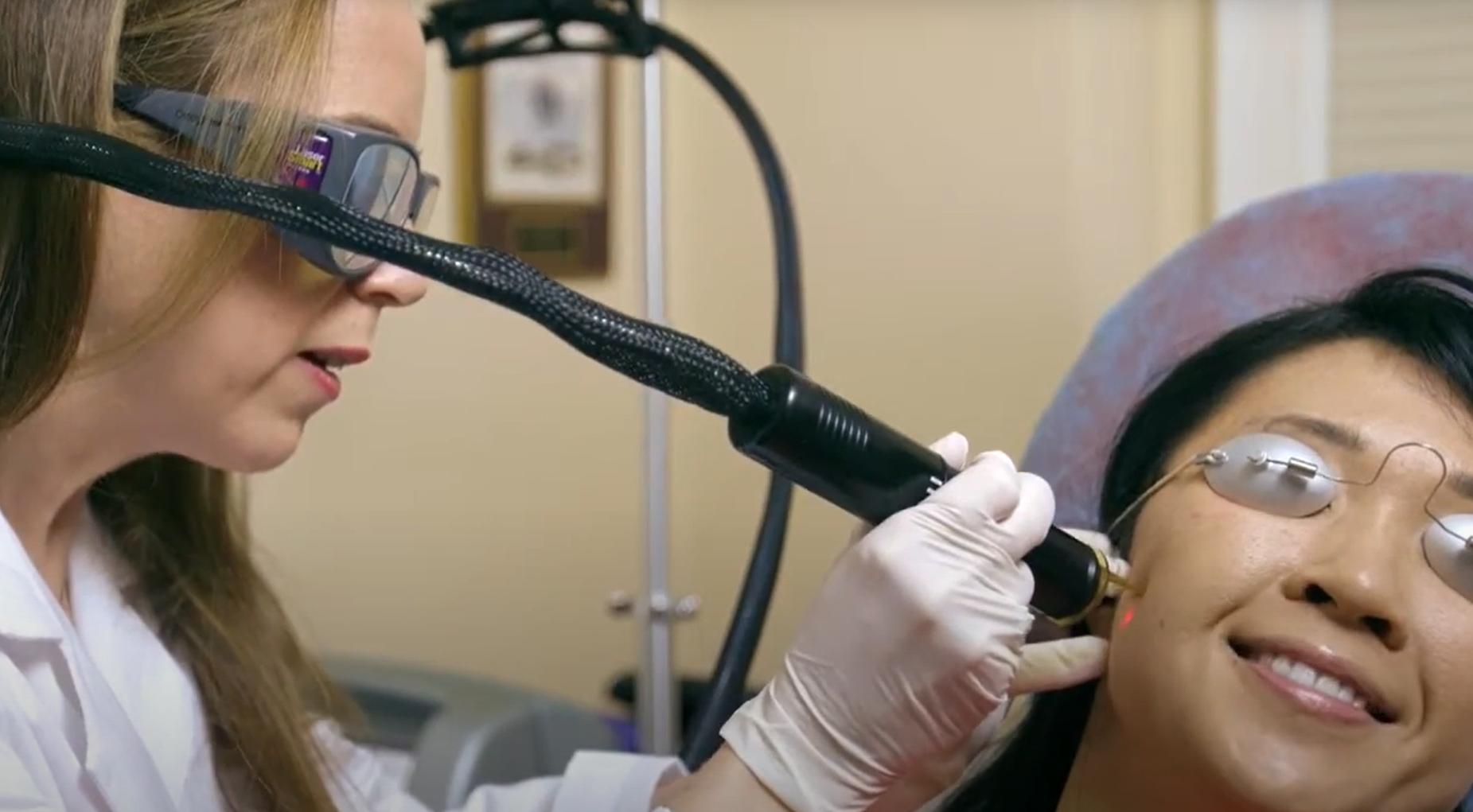
How to get started with dark spot removal treatment today
Dark spots, which are small patches of hyperpigmentation on the skin’s surface, can appear due to sun damage, which causes overproduction of the pigment melanin. While these dark spots are not dangerous, they usually begin to appear in middle age on the face, hands, arms, and neck and can be a highly visible reminder of the natural aging process. While dark spots will not fade on their own, there are many laser treatment options available to eliminate the appearance of hyperpigmentation with few treatment sessions and minimal downtime. To find out which laser treatment is safe and effective for you, schedule your initial consultation with Dr. Green today.
Expert board-certified dermatologist Dr. Michele Green is a master at treating a wide variety of skin conditions and cosmetic concerns. Always on the cutting edge of new technology and the best treatment methods, Dr. Green provides patients with the most effective treatment options available. Highly experienced in laser therapy, Botox, dermal fillers, chemical peels, microneedling, and more, Dr. Green is also well known for high patient satisfaction. To learn more about how laser treatment can eliminate sun damage without the need for significant downtime, please call Dr. Michele Green’s New York office today at 212-535-3088 or contact us online.
 212-535-3088
212-535-3088